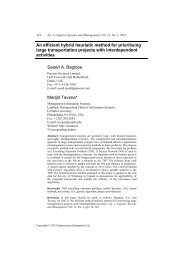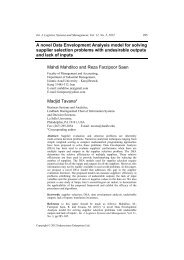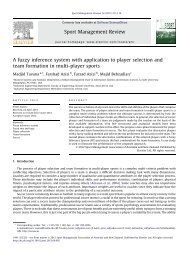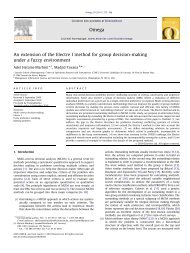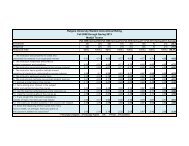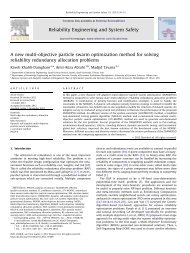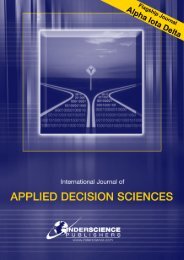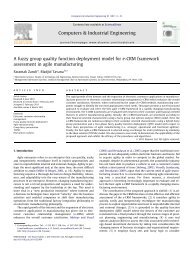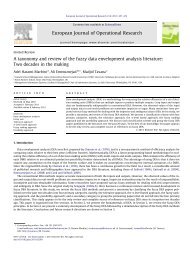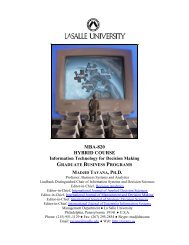A Fuzzy Multidimensional Multiple-Choice Knapsack - Dr. Madjid ...
A Fuzzy Multidimensional Multiple-Choice Knapsack - Dr. Madjid ...
A Fuzzy Multidimensional Multiple-Choice Knapsack - Dr. Madjid ...
You also want an ePaper? Increase the reach of your titles
YUMPU automatically turns print PDFs into web optimized ePapers that Google loves.
464 Ann Oper Res (2013) 206:449–483Fig. 5The DMU representation of a non-dominated solution3.3 Phase III: Pruning procedureThe selection of the final solution from the resultant non-dominated solutions is a difficulttask. In the previous section, both methods were used to generate a set of non-dominatedsolutions. In circumstances where the DM has no knowledge of the properties of the objectivesand the posterior articulation of the DM’s preferences, a systematic approach is neededto facilitate the final selection process. A pruning method such as Data Envelopment Analysis(DEA) can be used to decrease the final number of non-dominated solutions. DEA is amethodology for evaluating and measuring the relative efficiencies of a set of decision makingunits (DMUs) that use multiple inputs to produce multiple outputs. The DEA method isbased on the economic notion of Pareto optimality, which states that a DMU is considered tobe inefficient if some other DMUs can produce at least the same amount of output with lessof same input and not more of any other inputs. Otherwise, a DMU is considered to be Paretoefficient. Due to its solid mathematical basis and wide applications to real-world problems,much effort has been devoted to the DEA models since the pioneering work of Charnes et al.(1978). Each non-dominated solution of the modified NSGA-II algorithm is considered as aDMU with two inputs (i.e. cost and time) and one output (i.e. profit). Figure 5 presents theschematic view of a DMU.Let us assume that there are a set of n DMUs (DMU j , j = 1,...,n) producing s outputs(y rj , r = 1,...,s) by consuming m inputs (x ij , i = 1,...,m). We use the followingadditive model proposed by Charnes et al. (1982) to check whether a given DMU (i.e.,a non-dominated solution) is efficient.m∑ s∑max S − ip +i=1S rp+r=1s.t.n∑λ j x ij + S − ip = x ip,j=1i = 1, 2,...,mn∑λ j y rj − S rp + = y rp,j=1n∑λ j = 1j=1λ j ,S − ip ,S+ rp ≥ 0, r = 1, 2,...,s(15)where, S − ip and S+ rp are the input and output slacks and DMU p is efficient under the additiveModel (15) if and only if the optimal value of its objective function is zero.



